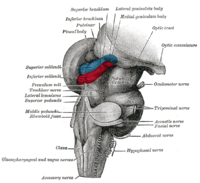
Photo from wikipedia
Absence epilepsy (AE) is a neurological disease that manifests in spike-wave discharges not present in healthy neuronal circuits. Mutations in ion channels directly underlying this rhythmic discharge may additionally affect… Click to show full abstract
Absence epilepsy (AE) is a neurological disease that manifests in spike-wave discharges not present in healthy neuronal circuits. Mutations in ion channels directly underlying this rhythmic discharge may additionally affect rhythms in multiple brain centres which disturbances contribute to the epileptic phenotype. Malfunctioning of the light detection system (from retina to subcortical visual structures), heavily dependent on oscillatory activities, could partially explain severe problems with sleep and arousal observed in epileptic patients. Therefore, the aim of our study was to evaluate characteristics of retinal-derived oscillations in the lateral geniculate complex of the thalamus; a major gateway for the light information flow for the brain. Extracellular recordings in vivo were performed on urethane-anaesthetised WAG/Rij and Wistar rats from single units in the identified parts of lateral geniculate complex to test their basic oscillatory features as well as reaction to transient and sustained changes in ambient light conditions. Here, we show altered rhythmic activity of the lateral geniculate neurons in the absence epilepsy model with the increase of both the infra-slow and fast oscillatory frequencies. Further, we describe their disturbed reaction to sustain change in ambient light and provide evidence for major changes in the intergeniculate leaflet neuronal firing; a part of the lateral geniculate complex implicated in the circadian timekeeping. Altogether, our results are the first to show a malfunctioning of light detection mechanisms in the absence epilepsy that may in turn underpin sleep-promoting system insufficiencies and other arousal disturbances contributing to epileptic phenotype.
Journal Title: Epilepsy research
Year Published: 2019
Link to full text (if available)
Share on Social Media: Sign Up to like & get
recommendations!